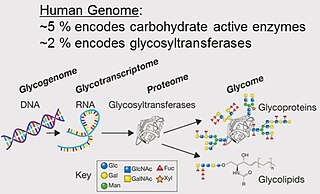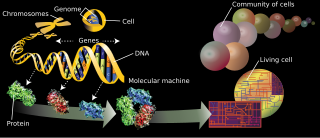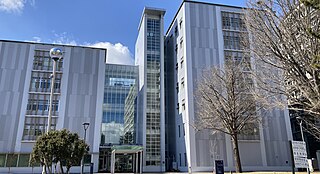Related Research Articles

The proteome is the entire set of proteins that is, or can be, expressed by a genome, cell, tissue, or organism at a certain time. It is the set of expressed proteins in a given type of cell or organism, at a given time, under defined conditions. Proteomics is the study of the proteome.

Genomics is an interdisciplinary field of molecular biology focusing on the structure, function, evolution, mapping, and editing of genomes. A genome is an organism's complete set of DNA, including all of its genes as well as its hierarchical, three-dimensional structural configuration. In contrast to genetics, which refers to the study of individual genes and their roles in inheritance, genomics aims at the collective characterization and quantification of all of an organism's genes, their interrelations and influence on the organism. Genes may direct the production of proteins with the assistance of enzymes and messenger molecules. In turn, proteins make up body structures such as organs and tissues as well as control chemical reactions and carry signals between cells. Genomics also involves the sequencing and analysis of genomes through uses of high throughput DNA sequencing and bioinformatics to assemble and analyze the function and structure of entire genomes. Advances in genomics have triggered a revolution in discovery-based research and systems biology to facilitate understanding of even the most complex biological systems such as the brain.
Glycomics is the comprehensive study of glycomes, including genetic, physiologic, pathologic, and other aspects. Glycomics "is the systematic study of all glycan structures of a given cell type or organism" and is a subset of glycobiology. The term glycomics is derived from the chemical prefix for sweetness or a sugar, "glyco-", and was formed to follow the omics naming convention established by genomics and proteomics.

A glycome is the entire complement or complete set of all sugars, whether free or chemically bound in more complex molecules, of an organism. An alternative definition is the entirety of carbohydrates in a cell. The glycome may in fact be one of the most complex entities in nature. "Glycomics, analogous to genomics and proteomics, is the systematic study of all glycan structures of a given cell type or organism" and is a subset of glycobiology.

The branches of science known informally as omics are various disciplines in biology whose names end in the suffix -omics, such as genomics, proteomics, metabolomics, metagenomics, phenomics and transcriptomics. Omics aims at the collective characterization and quantification of pools of biological molecules that translate into the structure, function, and dynamics of an organism or organisms.
The transcriptome is the set of all RNA transcripts, including coding and non-coding, in an individual or a population of cells. The term can also sometimes be used to refer to all RNAs, or just mRNA, depending on the particular experiment. The term transcriptome is a portmanteau of the words transcript and genome; it is associated with the process of transcript production during the biological process of transcription.
Regulome refers to the whole set of regulatory components in a cell. Those components can be regulatory elements, genes, mRNAs, proteins, and metabolites. The description includes the interplay of regulatory effects between these components, and their dependence on variables such as subcellular localization, tissue, developmental stage, and pathological state.

The lipidome refers to the totality of lipids in cells. Lipids are one of the four major molecular components of biological organisms, along with proteins, sugars and nucleic acids. Lipidome is a term coined in the context of omics in modern biology, within the field of lipidomics. It can be studied using mass spectrometry and bioinformatics as well as traditional lab-based methods. The lipidome of a cell can be subdivided into the membrane-lipidome and mediator-lipidome.
In, molecular genetics, an ORFeome refers to the complete set of open reading frames (ORFs) in a genome. The term may also be used to describe a set of cloned ORFs. ORFs correspond to the protein coding sequences (CDS) of genes. ORFs can be found in genome sequences by computer programs such as GENSCAN and then amplified by PCR. While this is relatively trivial in bacteria the problem is non-trivial in eukaryotic genomes because of the presence of introns and exons as well as splice variants.
Fluxomics describes the various approaches that seek to determine the rates of metabolic reactions within a biological entity. While metabolomics can provide instantaneous information on the metabolites in a biological sample, metabolism is a dynamic process. The significance of fluxomics is that metabolic fluxes determine the cellular phenotype. It has the added advantage of being based on the metabolome which has fewer components than the genome or proteome.

60S ribosomal protein L36 is a protein that in humans is encoded by the RPL36 gene.

Peroxisomal membrane protein PMP34 is a protein that in humans is encoded by the SLC25A17 gene.

Lethal(3)malignant brain tumor-like 2 protein is a protein that in humans is encoded by the L3MBTL2 gene.

Zinc finger protein 471 is a protein that in humans is encoded by the ZNF471 gene.

The exposome is a concept used to describe environmental exposures that an individual encounters throughout life, and how these exposures impact biology and health. It encompasses both external and internal factors, including chemical, physical, biological, and social factors that may influence human health.
The secretome is the set of proteins expressed by an organism and secreted into the extracellular space. In humans, this subset of the proteome encompasses 13-20% of all proteins, including cytokines, growth factors, extracellular matrix proteins and regulators, and shed receptors. The secretome of a specific tissue can be measured by mass spectrometry and its analysis constitutes a type of proteomics known as secretomics.

Multiomics, multi-omics, integrative omics, "panomics" or "pan-omics" is a biological analysis approach in which the data sets are multiple "omes", such as the genome, proteome, transcriptome, epigenome, metabolome, and microbiome ; in other words, the use of multiple omics technologies to study life in a concerted way. By combining these "omes", scientists can analyze complex biological big data to find novel associations between biological entities, pinpoint relevant biomarkers and build elaborate markers of disease and physiology. In doing so, multiomics integrates diverse omics data to find a coherently matching geno-pheno-envirotype relationship or association. The OmicTools service lists more than 99 softwares related to multiomic data analysis, as well as more than 99 databases on the topic.
Michael P. Snyder is an American genomicist and the Stanford B. Ascherman Professor, and since 2009, chair of genetics and director of genomics and personalized medicine at Stanford University. He is the former director of the Yale Center for Genomics and Proteomics. He was elected to the American Academy of Arts and Sciences in 2015. During his tenure as chair of the department at Stanford, U.S. News & World Report has ranked Stanford University first or tied for first in genetics, genomics and bioinformatics under his leadership.

Translatomics is the study of all open reading frames (ORFs) that are being actively translated in a cell or organism. This collection of ORFs is called the translatome. Characterizing a cell's translatome can give insight into the array of biological pathways that are active in the cell. According to the central dogma of molecular biology, the DNA in a cell is transcribed to produce RNA, which is then translated to produce a protein. Thousands of proteins are encoded in an organism's genome, and the proteins present in a cell cooperatively carry out many functions to support the life of the cell. Under various conditions, such as during stress or specific timepoints in development, the cell may require different biological pathways to be active, and therefore require a different collection of proteins. Depending on intrinsic and environmental conditions, the collection of proteins being made at one time varies. Translatomic techniques can be used to take a "snapshot" of this collection of actively translating ORFs, which can give information about which biological pathways the cell is activating under the present conditions.

The Tohoku Medical Megabank Project is a national project in Japan, which started in 2012. The mission of the Tohoku Medical Megabank (TMM) project is to carry out a long-term health survey in the Miyagi and Iwate prefectures, which were affected by the Great East Japan Earthquake, and provide the research infrastructure for the development of personalized medicine by establishing a biobank and conducting cohort studies.
References
- ↑ Yadav SP. (2007). "The Wholeness in Suffix -omics, -omes, and the Word Om". J Biomol Tech. 18 (5): 277. PMC 2392988 . PMID 18166670.
- ↑ "Error 403(Invalid User)".
- ↑ Wen, Siqi; Li, Jiajia; Yang, Jingru; Li, Biao; Li, Na; Zhan, Xianquan (2021). "Quantitative Acetylomics Revealed Acetylation-Mediated Molecular Pathway Network Changes in Human Nonfunctional Pituitary Neuroendocrine Tumors". Frontiers in Endocrinology. 12. doi: 10.3389/fendo.2021.753606 . ISSN 1664-2392. PMC 8546192 . PMID 34712204.
- ↑ Yagami T, Haishima Y, Tsuchiya T, Tomitaka-Yagami A, Kano H, Matsunaga K.; Haishima; Tsuchiya; Tomitaka-Yagami; Kano; Matsunaga (2004). "Proteomic analysis of putative latex allergens". Int Arch Allergy Immunol. 135 (1): 3–11. doi:10.1159/000080036. PMID 15286439. S2CID 35112557.
{{cite journal}}: CS1 maint: multiple names: authors list (link) - ↑ Wild CP (2005). "Complementing the genome with an "exposome": the outstanding challenge of environmental exposure measurement in molecular epidemiology". Cancer Epidemiol. Biomarkers Prev. 14 (8): 1847–50. doi: 10.1158/1055-9965.EPI-05-0456 . PMID 16103423.
- ↑ Faisandier, Laurie; De Gaudemaris, Régis; Bicout, Dominique J. (2009). "Occupational Health Problem Network : the Exposome". arXiv: 0907.3410 [stat.ME].
- ↑ Faisandier, Laurie; Bonneterre, Vincent; De Gaudemaris, Régis; Bicout, Dominique J. (2009). "A network-based approach for surveillance of occupational health exposures". arXiv: 0907.3355 [stat.ME].
- ↑ Cifuentes, A. (2009). "Food analysis and Foodomics". Journal of Chromatography A. 1216 (43): 7109. doi:10.1016/j.chroma.2009.09.018. hdl: 10261/154212 . PMID 19765718.
- ↑ "genome, n". Oxford English Dictionary . March 2008.[ dead link ]
- ↑ "Home". interferome.org.
- ↑ "Protein Snapshots". www.the-scientist.com. Archived from the original on December 2, 2008.
- ↑ Main Page – Interactomics Archived July 6, 2008, at the Wayback Machine
- ↑ Subramaniam S, Fahy E, Gupta S, Sud M, Byrnes RW, Cotter D, Dinasarapu AR, Maurya MR (2011). "Bioinformatics and Systems Biology of the Lipidome". Chemical Reviews. 111 (10): 6452–6490. doi:10.1021/cr200295k. PMC 3383319 . PMID 21939287.
- ↑ Pardo, Maria; Roca-Rivada, Arturo; Seoane, Luisa Maria; Casanueva, Felipe F. (2012). "Obesidomics: Contribution of adipose tissue secretome analysis to obesity research". Endocrine. 41 (3): 374–383. doi:10.1007/s12020-012-9617-z. PMID 22434412. S2CID 20503653.
- ↑ Schaechter M (2014-05-15). "Of Terms in Biology: The Parvome". Small Things Considered. Retrieved 2020-04-21.
- ↑ Davies J, Ryan KS (2012). "Introducing the parvome: bioactive compounds in the microbial world". ACS Chemical Biology. 7 (2): 252–259. doi:10.1021/cb200337h. PMID 22074935.
- ↑ (2011) "15th EBM PROGRAM" Archived 2016-01-26 at the Wayback Machine Evolutionary Biology Meeting at Marseilles. Retrieved December 14, 2011.
- ↑ Dov Greenbaum; Nicholas M. Luscombe; Ronald Jansen; et al. (2001). "Interrelating Different Types of Genomic Data, from Proteome to Secretome: 'Oming in on Function". Genome Research. 11 (9): 1463–1468. doi: 10.1101/gr.207401 . PMID 11544189.
- ↑ BBC article on the Speechome Project
- ↑ Synthetome
- ↑ Carlson, Scott M.; Gozani, Or (2014-10-09). "Emerging technologies to map the protein methylome". Journal of Molecular Biology. 426 (20): 3350–3362. doi:10.1016/j.jmb.2014.04.024. ISSN 1089-8638. PMC 4177301 . PMID 24805349.
- ↑ Huser, V.; Cimino, J. J. (2012). "Precision and Negative Predictive Value of Links between ClinicalTrials.gov and PubMed". AMIA Annual Symposium Proceedings. 2012: 400–408. PMC 3540528 . PMID 23304310.
- ↑ Bouhifd, Mounir; Andersen, Melvin E.; Baghdikian, Christina; Boekelheide, Kim; Crofton, Kevin M.; Fornace, Albert J.; Kleensang, Andre; Li, Henghong; Livi, Carolina (2015-01-01). "The human toxome project". ALTEX. 32 (2): 112–124. doi:10.14573/altex.1502091. ISSN 1868-596X. PMC 4778566 . PMID 25742299.
- ↑ DeFelipe, Javier (2010-11-26). "From the Connectome to the Synaptome: An Epic Love Story". Science. 330 (6008): 1198–1201. Bibcode:2010Sci...330.1198D. doi:10.1126/science.1193378. ISSN 0036-8075. PMID 21109663. S2CID 33348231.
- ↑ Kopell, Nancy J.; Gritton, Howard J.; Whittington, Miles A.; Kramer, Mark A. (2014-09-17). "Beyond the connectome: the dynome". Neuron. 83 (6): 1319–1328. doi:10.1016/j.neuron.2014.08.016. ISSN 1097-4199. PMC 4169213 . PMID 25233314.
- ↑ Dimitrov, DS (May–Jun 2010). "Therapeutic antibodies, vaccines and antibodyomes". mAbs. 2 (3): 347–56. doi:10.4161/mabs.2.3.11779. PMC 2881260 . PMID 20400863.